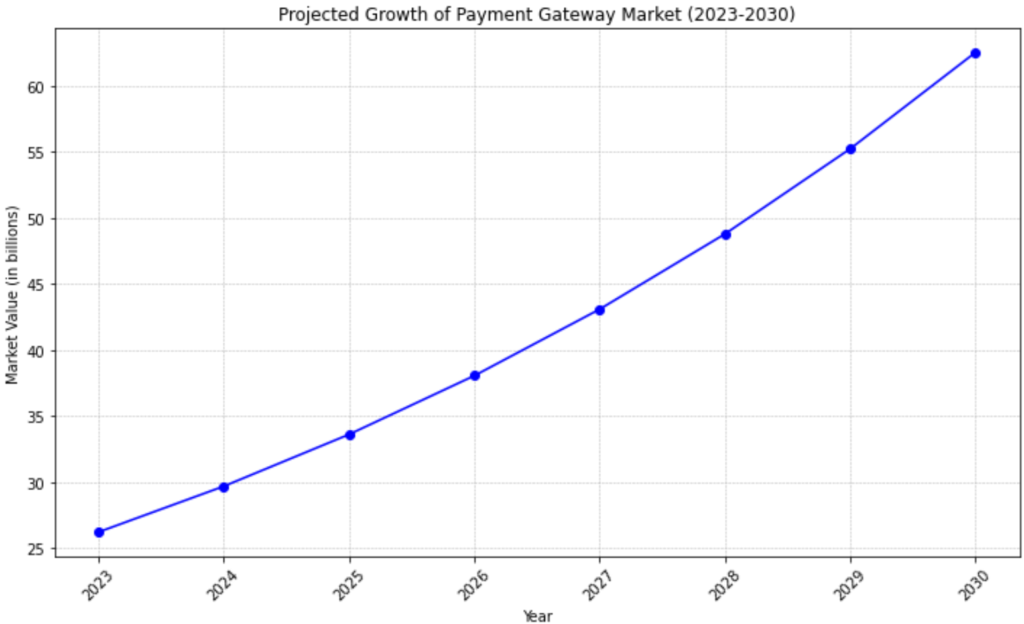Payment Gateways: Fuel for Online Growth
In today's digital era, cashless transactions are becoming the norm. With over 80% of purchases in the U.S. projected to be cashless by the end of 2022, the need for efficient and secure payment gateways is more crucial than ever.

Table of content
Table of Contents
Payment Gateway problems? We specialize in rapid troubleshooting and enhancements
Contact Us Let’sTalk
In today’s digital era, cashless transactions are becoming the norm. With over 80% of purchases in the U.S. projected to be cashless by the end of 2022, the need for efficient and secure payment gateways is more crucial than ever.
For businesses operating online, payment gateways are not just a convenience but a necessity. They serve as the digital equivalent of a physical cash register, processing credit card payments for e-commerce websites and brick-and-mortar stores alike. However, selecting the right payment gateway can be a challenging task, given the multitude of options available and the varying needs of different businesses.
This article aims to provide an in-depth understanding of payment gateways, their workings, types, limitations, and how to choose the perfect gateway for your business.
Decoding Payment Gateways: How Do They Work?
At the heart of any online transaction lies the payment gateway. It serves as the central component in the payment processing system, whether the transaction is made online or in-store.
In essence, a payment gateway is a conduit that facilitates the transfer and authorization of customer information in real-time to a merchant’s bank. There, the transaction is processed and completed. The gateway serves as a secure pathway, ensuring the safe transfer of sensitive financial data.

Exploring the Varieties: Types of Payment Gateways
Payment gateways can be broadly categorized into three types:
On-site Payments
Favoured by large-scale businesses, on-site payments are processed entirely on the merchant’s servers. The checkout experience and payment processing occur within the merchant’s system.
While this method provides greater control and responsibility over the transactions, it also demands a meticulous approach. Every facet of the shopping experience can influence the business’s bottom line, making it imperative for merchants to continually enhance their systems, particularly those with high sales volumes.
Off-site Checkout, On-site Payment
In this hybrid model, the customer completes the checkout process on the merchant’s site, but the payment processing happens off-site, on the gateway’s back end.
Although this method sacrifices some control over the user experience, it simplifies the payment process and enhances security, making it a viable option for businesses that prioritize safety.

Redirects
This method involves redirecting the customer to a third-party platform (e.g., PayPal) to complete the transaction. It’s an excellent option for small businesses looking to leverage the security and convenience of larger platforms without the need for complex integrations.
However, redirects can add an extra step for customers, potentially impacting the user experience. Therefore, businesses opting for this method should ensure a seamless redirection process to minimize customer drop-off.
Understanding the Limitations of Payment Gateways
Despite their critical role in facilitating online transactions, payment gateways are not without their limitations. Recognizing these potential drawbacks is crucial for businesses to make an informed decision.
Limited Acceptance of Cards/Payments
Contrary to popular belief, not all payment gateways accept all types of cards or payment methods. Certain card issuers and processing portals may not be compatible with all gateways. Before settling on a gateway, businesses should investigate its compatibility with the payment methods most used by their customers.
Limited Support for International Shoppers
For businesses targeting a global audience, it’s crucial to ensure their payment gateway can accommodate different online stores and payment platforms. For instance, in China, Alipay is more prevalent than options familiar to U.S. customers.
Moreover, international transactions may incur higher fees. While many gateways charge fixed transaction fees for both domestic and international transactions, some may impose additional charges for cross-border transactions.
Potential Security Vulnerabilities
With the rise of digital transactions, ensuring security is paramount. A study indicates that around two-thirds of consumers would cease shopping with a retailer previously impacted by a security breach.
While most high-quality payment gateways are secure, some potential vulnerabilities can pose a threat:
- Data Breaches: Even though most gateways employ TLS encryption to handle sensitive data, the server storing this data remains susceptible to breaches.
- Mobile Payment Issues: While the business may control transaction security, the security of the customer’s mobile device is beyond its control.
- Malware: Malware capable of reading passwords and infiltrating user accounts can initiate fraudulent transactions that appear genuine.

Choosing a Secure Payment Gateway: Things to Consider
When it comes to choosing a payment gateway, security should be a top priority. A recent Experian report reveals that 55% of consumers value security as the most crucial aspect of their online experience.
To ensure a secure payment gateway, businesses should consider the following factors:
Customer’s Preferred Payment Methods
Understanding the customer’s preferred payment methods can help businesses choose a compatible payment gateway, reducing potential issues and security risks.
Integration with Existing Technology
The gateway should be able to seamlessly integrate with the business’s existing technology platforms. A gateway that doesn’t align with your current solutions can complicate processes and slow down payments.
Payment Gateway Fees
The costs associated with ecommerce fraud can significantly impact your bottom line. If the savings from a gateway’s lower fees are offset by increased security costs and fraud detection, it may not be a viable investment.
Encryption Security
The payment gateway should comply with PCI standards to ensure secure encryption. The Payment Card Industry Data Security Standard (PCI DSS) is a set of standards designed to maintain security provisions for online transactions.
Reputation of the Gateway
Nearly half of the customers want to see visible security measures at the point of checkout. Therefore, businesses should opt for a payment gateway that is recognized and trusted by their customers.
Businesses should avoid gateways with questionable security histories to prevent customers from abandoning their shopping carts or opting for other, more secure sites. Established payment gateway providers like Amazon Pay, PayPal, and Apple Pay can instill confidence in customers and encourage them to continue shopping.
Flexibility of the Merchant Account
With the diverse types of shoppers and a multitude of payment options available, flexibility is a key attribute to look for in a payment gateway.
From credit cards like MasterCard and Visa to mobile options like Android and Apple Pay, a gateway that can accommodate a wide range of payment methods is a valuable asset for any business.

The Strategic Advantage of Stacking Payment Gateways
Businesses can mitigate some of the limitations of payment gateways by stacking them. Stacking involves employing multiple gateways on your ecommerce platform, maximizing the payment options available to your customers. This approach offers several benefits:
Enhanced Customer Convenience
By allowing more options for credit card transactions, businesses can provide more convenience to their customers and reduce friction at checkout.
Providing Alternative Options
Although more than 80% of American adults have a credit card, a significant market of customers prefers alternative payment options. By accommodating these options, businesses can ensure secure purchases for all customers.
The Bottom Line
Understanding the intricacies of payment gateways can help businesses make informed decisions, ensuring a secure and seamless online shopping experience for their customers.
With a platform like BigCommerce, businesses can choose from more than 65 pre-integrated online payment solutions, catering to 230 countries and over 140 currencies. These industry-leading solutions can turn your payment decisions into a strategic advantage for your business.
Payment Gateways List
| Payment Gateway | Pros | Cons | Best Industries |
|---|---|---|---|
| PayPal | Widely used and accepted, easy to set up, good fraud protection | Transaction fees, some complaints about holding funds, limited payment options | Online retail, software/SaaS, freelancers |
| Stripe | Easy integration, great APIs, strong fraud protection, wide currency support | Transaction fees, no recurring billing, more developer focus | Online retail, SaaS, subscription services |
| Square | Simple setup, good for small businesses, POS integration | Higher transaction fees, limited features for larger businesses | Retail stores, restaurants, small shops |
| Authorize.Net | Reliable, good recurring billing options, popular with enterprises | More complex setup, not ideal for low volume, lacks latest features | Large online businesses, subscription services |
| Braintree | Smooth integration, great APIs, owned by PayPal | Transaction fees, less flexibility than Stripe | Online retail, marketplaces, software |
| Dwolla | Low flat fees, fast bank transfers, good for high volume | Limited fraud protection, US-only, manual verification | Financial services, online marketplaces, large retailers |
| Skrill | Global payments, lower fees, high payment limits | Limited integrations and support | Online gambling, forex trading, high-risk industries |
| 2Checkout | Recurring billing, global payments, good fraud tools | High transaction fees, clunky interface | Digital goods/software, subscription services |
| Amazon Pay | Trusted brand, seamless integration, large user base | Must have Amazon account, limited customization | Online retail, especially Amazon sellers |
| Adyen | Global reach, unified commerce, advanced fraud protection | Complex setup, enterprise focus, high fees | Large online retailers, global ecommerce |
| Alipay | Access to Chinese consumers, escrow system, low fees | Limited primarily to Chinese market | Chinese consumers, cross-border ecommerce |
| WePay | Good for crowdfunding, simple interface, ACH support | Limited international, features lag behind leaders | Crowdfunding, donations, peer-to-peer |
| BitPay | Accepts cryptocurrencies, lower fees, customizable checkout | Volatile conversion rates, limited fraud protection | Cryptocurrency products and services |
| Payline Data | Flexible APIs, developer-friendly, feature rich | Training required, caters to enterprises | Large or complex ecommerce sites |
FAQs for Payment Gateways
What is the best payment gateway?
The best payment gateway depends entirely on your business’s specific needs, including the platforms you use for selling and the channels you operate in. PayPal might be the best option for an online business, while Square could be the ideal choice for physical locations. For startup businesses, Braintree could be a suitable bet.
What payment gateways work with BigCommerce?
BigCommerce works with more than 65 pre-integrated online payment solutions, serving 230 countries and over 140 currencies. These include PayPal, Square, Stripe, Apple Pay, Amazon Pay, Authorize.net, Adyen, Sezzle, 2CheckOut, Checkout.com, and WorldPay Core, among others.
What is the difference between payment gateways and payment processors?
A payment processor analyses and transmits transaction data to an issuing bank, such as the debit card or credit card information linked to a bank account. A payment gateway does the same but also authorizes the transfer of funds between buyer and seller.
What are high-risk payment gateways?
High-risk payment gateways are merchant account providers or platforms available for businesses operating in industries labeled as “high-risk.” These industries range from CBD and cannabis to adult entertainment. Due to the potential risks associated with these industries, many gateway providers decline to offer their services, leading to the emergence of high-risk gateways.


